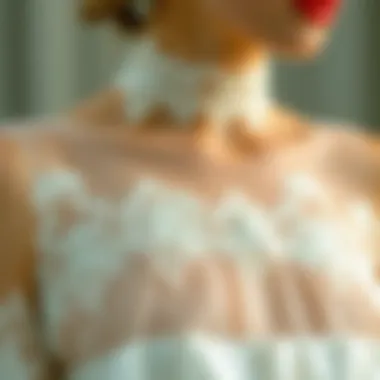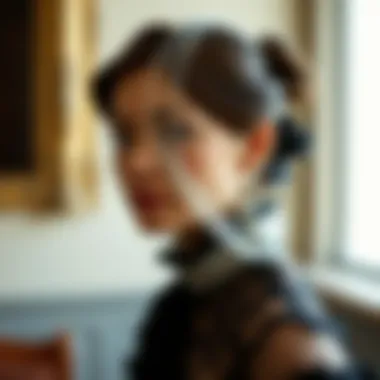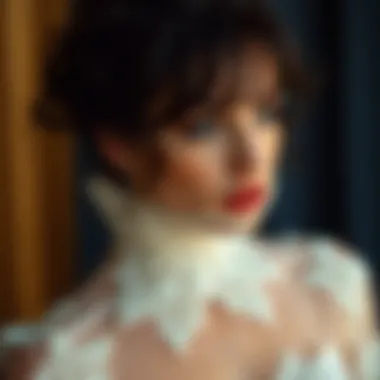The Multifaceted Role of Lace Trim in Fashion


Intro
Lace trim has always been an intriguing facet of fashion and crafting, inviting creativity while whispering tales of its rich past. From its inception centuries ago, lace has transitioned from a symbol of luxury to an accessible embellishment used to elevate everyday garments. Its delicate texture and intricate patterns can be found in everything from haute couture designs to DIY projects. In this exploration, we will unpack the versatility of lace trim, highlighting its historical significance, modern applications in design, and its growing importance in sustainable fashion practices.
Throughout this article, we'll delve into the latest fashion trends, examine seasonal highlights, and explore some influential runway looks that have redefined the way lace is perceived. Additionally, we'll shed light on sustainable practices in the realm of lace, discussing how ethical sourcing and eco-friendly clothing care are shaping the industry. With the rise of conscious consumerism, understanding the role of lace trim in crafting and fashion is essential for enthusiasts and professionals alike.
This guide aims not just to inform, but also to inspire those engaged in the vibrant world of lace, encouraging them to integrate it into their creative endeavors.
Understanding Lace Trim
Lace trim has carved out a unique niche in the realms of both fashion and crafting. Its ability to add depth and character to a wide array of items has made it an essential component. Learning about lace trim isn’t just about knowing its definition; it’s about grasping its possibilities and appreciating its cultural legacy. This section aims to highlight specific elements of lace trim that make it both versatile and significant in modern design.
Definition and Characteristics
Lace trim refers to a decorative textile edging, typically made of threads woven together to create intricate patterns. The beauty of lace lies not just in its appearance; various characteristics set it apart from other materials.
- Intricate Designs: Lace trim can range from delicate floral motifs to bold geometric patterns, offering a wide spectrum of aesthetic options.
- Texture Variety: The material may vary, encompassing cotton, silk, and synthetic fibers, which influences texture and durability.
- Lightweight and Flexible: Lace trim is generally lightweight, making it easy to sew onto different fabrics without adding bulk.
The beauty of lace trim lies in its adaptability; whether it's applied to a blouse, a home decor item like tablecloths, or accessories, it seamlessly fits into various environments.
Historical Context
The journey of lace trim is steeped in history, tracing back to its origins and significant cultural transformations through the ages.
Origins in Fashion
The birth of lace can be traced back to the 15th century in Europe. Initially, it was a symbol of wealth and nobility, frequently seen in garments of royalty. This luxurious aspect of lace trim has made it a staple in haute couture, offering an air of sophistication to any piece it enhances.
- Key Characteristic: Lace in the early days was often handmade, thus showcasing exquisite craftsmanship and artistry.
- Benefit: Its introduction into fashion has provided designers with a canvas for creativity, allowing unique designs that embrace both tradition and innovation.
- Unique Feature: The time-consuming process of creating lace by hand meant it was limited in availability, thus often used in exclusive collections.
Cultural Significance Across Eras
Lace trim has been more than a mere fashion accessory; it's served as a historical marker, reflecting the changes in societal values and styles across different eras. Lace has made its way through revolutions in design, adapting to the whims of the time.
- Key Characteristic: From the Renaissance's elaborate motifs to the minimalist designs of the modern era, lace trim has consistently represented innovation in textile artistry.
- Benefit: Its versatility has allowed it to resonate across different cultures, making it a global phenomenon, appearing in everything from traditional garments to contemporary designs.
- Unique Feature: Cultural shifts have often influenced the patterns and applications of lace, leading to a diverse range of lace designs that speak to the societal narratives of their time.
In summary, understanding lace trim is critical as it sets the stage for exploring its diverse uses and evolving significance in the fashion and crafting world. Recognizing its rich history and various characteristics underscores why it remains a coveted choice in design today.
Types of Lace Trim
Understanding the various types of lace trim is vital in grasping its significance in both fashion and crafting. Each type brings its own unique characteristics, influencing how it can be effectively utilized in diverse projects. By examining the distinct properties of cotton, synthetic, and silk lace, we can appreciate their unique benefits and considerations.
Cotton Lace
Use in Apparel
Cotton lace trim is a timeless classic, widely recognized for its versatility and comfort. It's often used in garments, bringing with it a soft texture that hugs the skin. This fabric works wonders in designs ranging from chic summer dresses to cozy nightwear. One of cotton lace's key characteristics is its breathability, which makes it a favorable choice in warmer climates. However, its absorbent nature means it could get damp quickly in humid conditions.
A unique aspect of cotton lace is its ability to be dyed easily, making it an ideal option for custom colors in personal design projects. Despite its many advantages, it's essential to consider that cotton may not hold up as well in high-stress applications compared to other materials, so keep that in mind when selecting it for your next project.
Durability and Care
When it comes to durability, cotton lace is moderately robust but may require more thoughtful care compared to synthetic options. Washing it in gentle cycles with cold water prolongs its lifespan, preventing potential shrinks or tears. Notably, this lace tends to fray if the edges are not properly finished, which can be a drawback in some designs.
The advantage lies in its natural fibers, appealing for those conscious of fabric composition. If you're seeking an aesthetically pleasing yet affordable material for items like home textiles or delicate crafts, cotton lace is an excellent pick, though expecting some meticulous maintenance is reasonable.


Synthetic Lace
Cost-Efficiency
Synthetic lace is often lauded for its cost-efficiency, making it an attractive option for projects that need to stick to budget constraints. The affordability of synthetic lace makes it a popular choice among designers and those engaged with fast-fashion trends. This type of lace offers a similar appearance to that of lace made from natural fibers but at a considerably lower price point.
Though less expensive, synthetic lace can sometimes sacrifice quality for price. It tends to be less breathable and can feel uncomfortable against the skin during prolonged wear. Nevertheless, for one-time events or garments not worn frequently, its economical value often outweighs its comfort shortcomings.
Applications in Fast Fashion
Synthetic lace has found a firm footing in fast fashion, where companies strive for quick turnarounds and minute-cost production. Its production process is tailored for mass-market appeal, making it easy to incorporate into various designs. Whether it’s added as accents on dresses or layering in casual tees, synthetic lace provides a trendy touch without breaking the bank.
However, a critical consideration is the environmental impact of synthetic fabrics. The non-biodegradable nature of most synthetic materials can pose sustainability challenges, which is something increasingly relevant in today’s conscientious fashion landscape. Fashion enthusiasts would do well to reflect on these factors when opting for synthetic pieces.
Silk Lace
Luxury Fashion Applications
Silk lace is often reserved for high-end applications and luxury fashion, making it a symbol of opulence in garments. Favored by designers crafting wedding dresses and evening gowns, silk lace brings a level of sophistication unattainable by lesser materials. Its soft draping quality adds elegance and allure to any piece, making it a choice for those who prioritize aesthetics.
Notably, silk lace features intricate designs that can create stunning visual effects, enhancing overall garment appeal. While undeniably luxurious, this choice comes at a premium cost, making it less accessible for everyday fashion pursuits. Still, for those willing to invest, silk lace serves as a hallmark of refinement.
Maintenance and Longevity
Maintaining silk lace involves a bit of fuss, given its delicate nature. Typically, dry cleaning is recommended to preserve its beauty and longevity. Despite its susceptibility to damage if not cared for properly, when maintained well, silk lace can last through seasons, retaining its luxurious appeal.
One unique feature is the ability of silk to be lightweight yet remarkably durable, which can translate to longevity in high-quality designs, making it an investment worth considering for long-term style. That said, individuals need to factor in both the cost and care instructions before diving into projects with this exquisite material.
Fashion Trends Featuring Lace Trim
Fashion trends featuring lace trim highlight the delicate and stylish nature of the fabric, making it an essential element in various designs. The relevance of lace trim in today's fashion scene cannot be overstated; it is a tool that aids designers in creating pieces that evoke a spectrum of emotions, from romance to edginess. Lace trims not only add texture and visual interest but also serve as a bridge between traditional craftsmanship and contemporary aesthetics, allowing for a unique blend of old and new.
Romantic Aesthetics
Other Design Elements
Other design elements that complement lace trim often include soft fabrics like chiffon or satin. These materials create a dreamy, ethereal quality, magnifying the charm of the lace itself. Combining lace with floral prints or pastel colors can amplify its romantic character, making pieces feel light and airy—ideal for spring and summer collections.
That said, one key characteristic of these complementary elements is their ability to balance the heaviness of lace with lighter fabric choices. This creates a harmonious look that feels both fanciful and grounded. On the flip side, while it is a beneficial approach in many situations, careful consideration is needed to not overdo it, as too many competing elements can muddle the ethereal vibe you are aiming for.
Layering Techniques
Layering techniques are also pivotal in achieving a fresh take on romantic aesthetics. By layering lace trim over or under other fabrics, designers can create depth and interest. A lace trim extending from beneath a chiffon sleeve can add an unexpected surprise, inviting closer inspection.
This technique is beneficial because it allows for versatility in styling, enabling wearers to transition from formal to casual settings seamlessly. A potential disadvantage, however, is the careful thought required to ensure the lace doesn’t overwhelm the other layers, thus making it essential to maintain a sense of balance in your overall look.
Modern Minimalism
Subtle Incorporations in Casual Wear
Subtle incorporations of lace trim in casual wear are gaining traction as minimalism takes root in everyday fashion. Adding a hint of lace to a simple t-shirt or jean jacket can bring a touch of elegance without overshadowing the wearer's personality. This nuanced approach allows designers and wearers alike to embrace chicness in a low-key manner.
The pleasing aspect of this trend is how effortlessly one can elevate their wardrobe. Just a dash of lace, perhaps around the collar or hem, can transform a basic outfit into something special. On the downside, if executed poorly, the whole aesthetic can detract from the easy-going vibe that defines casual wear.
Balancing Simplicity and Detail
Achieving a balance between simplicity and detail is crucial to modern minimalism, especially concerning lace trim. The goal is to enhance the overall design without cluttering it. Key characteristics of this approach include clean lines combined with strategic lace placements, so the trim serves as a focal point rather than a distraction.


This balance brings a refined quality to garments, making them suitable for various occasions. However, if not implemented with care, it could result in a piece feeling either too plain or excessively fussy—illustrating the fine line between minimalism and lack of interest.
Gothic Inspirations
Dark Romanticism
Gothic inspirations bring a distinctive twist to lace trim. Dark romanticism pairs well with lace, capturing an allure that is both captivating and mysterious. Elements like dark hues and intricate patterns are hallmarks of this style, where lace adds a layer of depth to the entire ensemble.
This trend is favored because it allows wearers to express their unique individuality and embrace a more dramatic sentiment without going overboard. Yet, a cautionary note here—overly abundant lace paired with the dark tones might suppress the aesthetics of the darker elements instead of enhancing them.
Juxtaposition with Edgier Fabrics
The juxtaposition of lace trim with edgier fabrics like leather or denim underscores the versatility of lace in modern fashion. When lace is layered with these robust materials, it creates a thrilling contrast that accentuates both elements beautifully.
This combination attracts attention and is popular for its unexpectedness. It sparks conversations and tends to attract a diverse audience. One downside could be the challenge of harmonizing the textures; without the right balance, the delicate lace could get lost in the boldness of the other fabrics.
Combining lace with various fabric textures can lead to innovative design solutions that promote individuality and creativity in fashion.
Applications in Crafting
The versatility of lace trim finds remarkable expression in crafting, where it enhances both functionality and aesthetics. By integrating lace into various projects, crafters not only elevate the visual appeal of their creations but also explore the intricate dimensions lace offers. The importance of lace trim in crafting lies in its ability to transform ordinary items into extraordinary pieces, making it essential for those looking to add a unique touch to their work.
DIY Projects
Home Decor Enhancements
In the realm of home decor, using lace trim can breathe new life into mundane items. Think about that plain lampshade lying around—adding a delicate lace trim at its base might just turn it into a statement piece. This application highlights the transformative aspect of lace trim. It allows an individual touch that mirrors personal style. The lace can create various visual effects, from romantic to bohemian vibes, depending on how it’s utilized.
A key characteristic of such enhancements is their ability to add texture and depth to simpler items. By integrating lace, crafters can enhance age-old pieces or thrift finds, making them relevant again in today's design world. The unique feature here is its versatility: lace can harmonize with other materials, such as rustic woods or sleek metals, ensuring a captivating contrast.
However, there can be a downside. Not all lace trims might withstand heavy wear and tear in an active household, and delicate designs might need gentle handling. Yet, the charm it brings can outweigh these considerations, making lace a worthy investment for decor enthusiasts, allowing personal landscapes to narrate stories of both history and style.
Creating Custom Accessories
On another note, lace trim has gained popularity in the crafting of custom accessories. Within this creative domain, it permits crafters to design unique items, from hairbands to elaborate brooches. The inherent delicacy of lace trim adds an air of sophistication, even to simple accessories. It provides a chance to express creativity while ensuring that pieces stand out from the crowd.
Custom accessories made with lace often become talking points. This characteristic is crucial for those seeking to encapsulate individuality in their style. Transforming a basic simple bag by adding a strip of lace can instantly elevate its appeal and marketability.
Yet, one should consider the nature of the lace used. While lace can indeed enhance appearance, it can sometimes limit functionality, making certain designs less robust. Therefore, crafters must judiciously choose lace that not only complements the design but also aligns with the intended use of the accessory.
Sustainable Practices in Crafting
Upcycling with Lace Trim
The act of upcycling with lace trim signifies a thriving trend within the crafting community, reflecting a growing awareness of sustainability. Many crafters are using leftover lace scraps from larger projects, finding ways to breathe new life into their old garments or forgotten fabric. This contributes not only to reducing waste but also to promoting a circular economy within the arts and crafts field.
The uniqueness of this application lies in the creativity it sparks. Crafters can think beyond simply applying trim; they can patch up worn fabric, stitch lace into quilts, or create one-of-a-kind table runners. Not only does this practice help minimize waste, but it also fosters a sense of pride in making "new" items from something once deemed as "old."
The potential drawbacks could be the limited availability of suitable lace and the time which may go into finding the right pieces for a cohesive look. However, many artisans find these challenges to be invigorating rather than hindering, often leading to innovative solutions that are surprisingly elegant.
Choosing Eco-Friendly Materials
Choosing eco-friendly materials is another critical element when incorporating lace trim in crafting, especially in today’s environmentally-conscious culture. Crafters are increasingly gravitating towards organic cotton or bamboo lace, which are sustainable alternatives to traditional options. This commitment to using sustainable materials allows for a wholesome crafting experience that aligns with personal values.
The key characteristic of this trend is the focus on sustainability within the arts. By opting for eco-friendly lace, crafters contribute to reducing their carbon footprint, ensuring that their projects do not harm the environment.
Though eco-friendly options may come at a higher initial cost, the long-term benefits—including durability and the satisfaction of actively participating in sustainable practices—far outweigh the negatives. Moreover, there's a growing market for such materials, indicating a bustling interest in ethically sourced lace trim.


Lace trim opens a world of creative possibilities, allowing you to rethink and repurpose everyday items into cherished works of art.
Lace Trim in Personal Style
Incorporating lace trim into one’s personal style is more than just a fashion statement; it's a means of artistic expression. This delicate element serves as a canvas that reflects individuality, enhancing one’s aesthetics while offering an adaptable outlet for creativity. The interplay between lace and personal style creates unique opportunities for both subtle elegance and bold statements.
Enhancing Individual Aesthetics
Statement Pieces
Statement pieces are transformative elements within an outfit that command attention and convey a specific style narrative. Lace trim, when used in statement pieces, stands out due to its intricate designs and textures. These elements not only draw the eye but also evoke a sense of story, providing layers of meaning behind the fashion choice. The key characteristic of statement pieces adorned with lace trim is their ability to add depth to an ensemble without overwhelming the overall look. This makes them a beneficial choice for anyone looking to elevate their wardrobe.
A unique feature of lace-trimmed statement pieces is their versatility; they can seamlessly fit into various contexts, from elegant gatherings to casual outings. However, it’s essential to strike a balance—overdoing lace can shift the focus from other elements of an outfit. Thus, incorporating it thoughtfully can lead to a striking visual impression.
Layering with Other Textiles
Layering with lace trim invites an intriguing play of textures and dimensions that can redefine standard outfits. The key characteristic of this layering approach is its ability to soften harsher materials or enhance simpler outfits. This practice not only adds complexity to one’s attire but also showcases personal style in a practical way. Using lace as a layering agent can be particularly advantageous in creating depth, allowing multiple fabrics to coexist, interacting seamlessly in terms of both color and form.
One notable unique feature of layering with lace is its capacity to create visual contrasts; for example, pairing it with denim or leather can result in a balanced and modern appeal. However, the possible disadvantage lies in the risk of misalignment; not all textiles harmonize well, which could lead to a disjointed appearance. Therefore, thoughtful decisions about color and texture combinations become crucial in curating a refined look.
Seasonal Trends
As styles evolve with the seasons, lace trim finds its place in the shifting landscape of fashion, adapting and thriving through changing trends. Its flexibility allows it to be embraced in various formats, catering to both summer vibrancy and winter coziness.
Summer Style Uses
Lace trim takes on a notable role during the summer, where the delicate fabric comes alive in bright designs and airy materials. The key characteristic of summer style uses for lace trim is its inherrent lightness; it breathes sophistication into warm-weather wardrobes. Whether integrated into sundresses or as accents on lightweight blouses, this element adds a refreshing touch that captures the essence of the season.
The unique feature of summer lace uses lies in its ability to transform casual styles into chic ensembles. However, one must be cautious as overly intricate lace structures might feel heavy, making it counterproductive in the heat. Therefore, selecting the right patterns becomes vital in keeping the outfit breezy and comfortable.
Winter Layering Techniques
During winter, lace trim demonstrates its versatility through clever layering techniques that provide warmth without sacrificing style. The key characteristic of winter layering with lace is its capacity to add warmth while still allowing for rich visual textures. A lace-trimmed cardigan over a robust sweater or a lace hem peeking under a heavy coat can introduce elegance to winter gear.
A distinct unique feature of these techniques is that they provide opportunities for playing with contrast; lace can lighten the heaviness of winter fabrics. The potential downside, however, might be in terms of care; lace can often require delicate handling, especially in colder, harsher environments. Ultimately, ensuring the right balance in layering with lace is essential for maintaining both functionality and flair.
"Fashion is not about what you wear, but how you wear it—lace trim can be the fine line between ordinary and extraordinary."
In summary, lace trim’s integration into personal style presents vast opportunities for individual expression, making it a profoundly significant element in contemporary fashion discussions. Engaging with this trim not only allows for tailored aesthetics but also invites experimentation with textiles, creating a fashion sense that is as unique as the person wearing it.
Ending: The Future of Lace Trim
In assessing the trajectory of lace trim within fashion and crafting, one must acknowledge its evolving significance in contemporary design and personal style. As we gaze into the horizon, it is clear that lace is not simply a remnant of the past; it embodies potential for innovation and sustainability. Lace trim serves a diverse range of functions—ranging from aesthetic enhancement to practical utility. Its adaptability in meeting the demands of modern consumers speaks to the artistry and craftsmanship engrained within this delicate material.
Emerging Trends to Watch
With the rise of entrepreneurship in fashion and a growing desire for individuality, lace trim is poised to undergo several transformations. Some notable trends include:
- Eco-Conscious Materials: As the fashion industry becomes more aware of its environmental impact, eco-friendly lace options emerge. This shift not only appeals to consumers but also showcases the versatility and evolution of this material.
- Technological Integration: Laser-cut lace and digital printing techniques are opening new avenues for creativity. Designers can blend traditional lace aesthetics with cutting-edge technology, creating pieces that tell a unique story.
- Functional Fashion: The merging of practicality with elegance is evident in recent designs. Lace trim finds itself in athleisure and casual wear, fostering a relaxing yet refined vibe.
Integrating Lace Into Future Fashion
Sustainability and Innovation
The incorporation of sustainability into fashion has gained remarkable traction. The demand for sustainable practices within the fashion industry lends lace an enhanced role. While lace itself is often perceived as lavish, its potential for environmental responsibility is significant.
Eco-conscious brands are beginning to use upcycled lace and natural fibers sourced from responsible producers. This adaptation encourages a mindful consumer culture, reflecting broader societal shifts towards sustainable practices. The inviting allure of lace becomes an ethical consideration, enriching its narrative in today’s marketplace.
Cross-Disciplinary Collaborations
Collaborations between various creative disciplines foster innovation in lace applications. Designers are increasingly working with artists, fabric technologists, and even architects to reimagine lace. By integrating lace into unexpected projects—such as interior design or even technology—the versatility of this embellishment amplifies. The unique characteristic here is the fusion of tactile craftsmanship with modern artistic vision. These cross-disciplinary collaborations not only invigorate the fabric but also broaden its appeal across diverse markets. However, such partnerships can sometimes lead to conflicting aesthetics, presenting a challenge for designers in maintaining coherence with brand identity.
"Fashion is the armor to survive the reality of everyday life." - Bill Cunningham
In summary, the future of lace trim is a tapestry woven with threads of innovation, sustainability, and cross-disciplinary artistry. As fashion continues to evolve, so too does lace, redefining its place in both crafting and style. By closely observing these emerging trends, we can anticipate a renaissance for this age-old material, where it not only retains its charm but also enriches the modern aesthetic.







